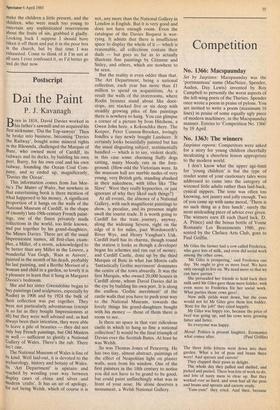Postscript
Dai the Paint
P. J. Kavanagh
orn in 1818, David Davies worked in LA his father's sawmill and so acquired his first nickname, 'Dai the Top-sawyer'. Then he broke into business, becoming `Davies the Railway', bought some mineral rights in the Rhonnda, challenged the Marquis of Bute, who owned most of Cardiff, its railways and its docks, by building his own Port, Barry, for his own coal and his own railway, founding the Ocean Coal Com- pany, and so ended up, magnificently, `Davies the Ocean'.
This information comes from Jan Mor- ris's The Matter of Wales, but nowhere in that entertaining book is there mention of what happened to his money. A significant proportion of it hangs on the walls of the National Museum of Cardiff, in the shape of (mostly) late-19th-century French paint- ings, one of the finest privately made collections in the world, too little known, and put together by his grand-daughters, the Misses Davies. There are all the usual Impressionist names, all first-class exam- ples, a Millet, of a storm, acknowledged to be better than any Millet in the Louvre, a Wonderful Van Gogh, 'Rain at Auvers', Painted in the month of his death, probably his last painting, and a Berthe Morisot of a woman and child in a garden, so lovely it is a pleasure to learn that it hung in Margaret Davies's bedroom.
She and her sister Gwendoline began to buy paintings (and sculptures, especially by Rodin) in 1908 and by 1924 the bulk of their collection was put together. They were not particularly adventurous (except in so far as they bought Impressionists at all) but they were well advised and, as had always been their intention, they were able to leave a pile of beauties — they did not only buy French paintings, but Old Masters as well — sufficient to glorify a National Gallery of Wales. There's the rub. There isn't one.
The National Museum of Wales is fine of its kind. Well laid-out, it is devoted to the archaeology, history and botany of Wales. Its 'Art Department' is upstairs and reached by wending your way between display cases of china and silver and Modern 'crafts'. It has an air of apology, for not being Welsh, which of course it is not, any more than the National Gallery in London is English. But it is very good and does not have enough room. Even the catalogue of the Davies Bequest is wor- rying. It admits that there is insufficient space to display the whole of it — which is reasonable, all collections contain their duds — but goes so far as to actually illustrate fine paintings by Cezanne and Sisley, and others, which are nowhere to be seen.
But the reality is even odder than that. The Art Department, being a national collection, each year has more than £1 million to spend on acquisitions. As a result the walls of the storerooms, where Rodin bronzes stand about like door- stops, are stacked five or six deep with steadily growing piles of fine paintings there is nowhere to hang. You can glimpse a corner of a picture by !von Hitchens, a Gwen John here, a Kokoschka there. The Keeper, Peter Cannon-Brookes, lovingly fondles a tiny newly bought Landseer. It certainly looks beautifully painted but has the usual disgusting subject, sentimentally handled — which is to say, violent death; in this case some charming fluffy dogs ratting, many bloody rats in the fore- ground. (How odd the Victorians were. In the museum hall are marble nudes of very young, very British girls, standing abashed in their nakedness, with titles like 'The Slave'. Were they really hypocrites, or just ignorant of why they liked such things?) At all events, the absence of a National Gallery, with such magnificent paintings to show, is peculiar, and its presence might swell the tourist trade. It is worth going to Cardiff for the train journey, anyway, along the widening Severn, right on the edge of it for miles, past Wordsworth's River Wye, and Henry Vaughan's Usk. Cardiff itself has its charms, though round the station it looks as though a developer began his schemes and ran out of money; and Cardiff Castle, done up by the third Marquis of Bute in what Jan Morris calls 'fantastically Gothic merriment' dominates the centre of the town absurdly. It was the first Marquis, who owned 20,000 houses in Cardiff alone, whom David Davies did in the eye by building his own port. It is along the endless 'Gothic merriment' of the castle walls that you have to push your way to the National Museum, towards the lovely things his grand-daughters bought with his money — those of them there is room to see.
Is there no space in that vast ridiculous castle in which to hang so fine a national collection? It would be the final triumph of Davies over the Scottish Butes. At least he was Welsh.
So was Thomas Jones of Pencerrig. He has two tiny, almost abstract, paintings of the effect of Neapolitan light on plaster walls, seen from his window. One of the first painters in the 18th century to notice you did not have to be grand to be good, but could paint unflinchingly what was in front of your nose. He alone deserves a monument, a Welsh National Gallery.










































 Previous page
Previous page